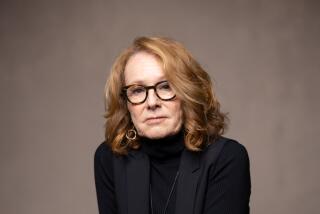What this MacArthur winner, an expert in African American art history, plans to do with her grant
Kellie Jones wants a new desk. That was the first thing the art historian and curator decided she would buy with the grant she will receive as one of 23 MacArthur Fellowship recipients announced Wednesday night.
Jones’ focus has been African American and African diaspora artists, and her goal has been understanding what constitutes modern and contemporary art history. She also has worked with Latino and Latin American artists, and she is passionate about making sure art history reflects the global reality of art.
“My work has explored parts of art history that are unexamined,” Jones said. It has also unearthed artists who have been unknown, underexplored or forgotten.
That has been her creative pursuit for as long as Jones, 57, has had her desk — the same desk she’s had since college, the curator said by phone from New York City, where she is an associate professor in the department of art history and archaeology at Columbia University. “It’s in New York with me now — it took a detour to Connecticut as well.”
College was Amherst, and Connecticut was Yale, where Jones received her PhD in 1999. She was on the faculty at Yale from the completion of her doctorate until 2006, when she moved to Columbia.
A new desk is a modest first ask for a recipient of the grant, which comes with a no-strings-attached stipend of $625,000 paid in quarterly installments over five years. Sometimes called a “genius grant,” the awards are handed out annually to individuals in any field who have, according to the John D. and Catherine T. MacArthur Foundation, “shown extraordinary originality and dedication in their creative pursuits and a marked capacity for self-direction.”
Jones said an award of that scale is an invitation to continue doing what she has been doing — only now she can take more risks and “think bigger.” She said she also will look for more ways to work collaboratively.
Museums now understand better the role of a variety of objects in narrating what art history is.
— Kellie Jones
One of Jones’ most lauded achievements was curating a 2011 show at the Hammer Museum in Los Angeles titled “Now Dig This! Art and Black Los Angeles, 1960-1980.” The exhibit featured 130 paintings, drawings, sculptures and videos by 33 artists. Times art critic Christopher Knight wrote a glowing review, noting that “Now Dig This!” tells “an important story that is not so much unknown as underknown.”
Knight continued: “Many of the individual artists — Melvin Edwards, John Outterbridge, Noah Purifoy, Betye Saar, Charles White and others — are certainly familiar, while David Hammons ranks among the most important American artists of the last 30 years. What hasn’t been the focus before now is the context within which their work developed. ‘Now Dig This!’ lays it out with clarity and compelling insight.”
Context is key to Jones’ work, a reason why the Hammer show also featured work by artists from a number of ethnicities.
“People don’t work in a vacuum, so there were also people we called ‘friends,’ ” Jones said. “Latino artists, white artists, African American artists from the Bay Area.”
Jones found inspiration in the work of these artists, many of whom had been quietly creating in relative obscurity for decades.
“They keep doing it and the objects are still there,” Jones said. “I believe in the evidence that objects give us.”

Jones is excited about the timing of her grant and said it represents real growth in her field. She noted that the Smithsonian’s National Museum of African American History and Culture is opening this weekend in Washington, D.C.
“That’s the type of work I’m doing,” she said with excitement. “And now to have something that people from all over the world will visit and say, ‘This is part of U.S. history — this is part of American culture.’ ”
That represents a seismic shift from 1970, she said.
“Museums now understand better the role of a variety of objects in narrating what art history is,” Jones said.
Another goal for Jones is to finish a book titled “Art Is an Excuse.”
By that she means that art is an excuse for collaboration and social activism. To write that book, she has been looking at “global conceptual art networks” of the 1960s and 1970s. And, yes, she will finish that book on her new desk.
Also:
Larry Clark turns life into photo exhibit at new United Talent Agency Gallery
Review: ‘Doug Aitken: Electric Earth’: Why MOCA’s big new show has too few sparks
The anti-mega gallery: The impromptu shows at Henry Taylor’s living room exhibition space
More to Read
The biggest entertainment stories
Get our big stories about Hollywood, film, television, music, arts, culture and more right in your inbox as soon as they publish.
You may occasionally receive promotional content from the Los Angeles Times.











